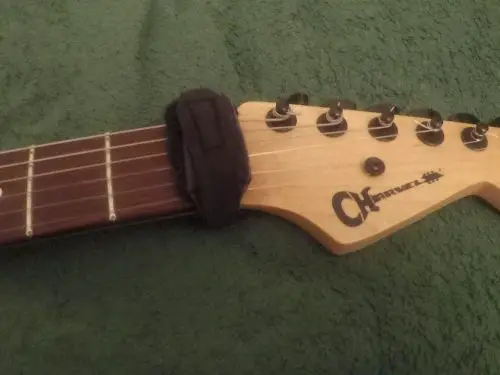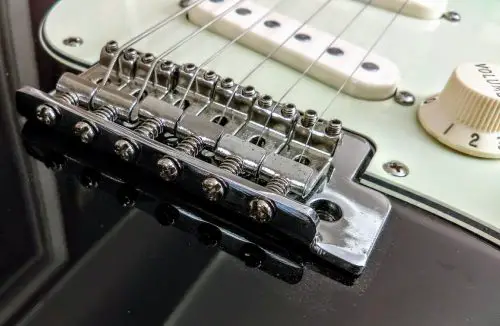Is It Cheating to Use a Fret Wrap?
Using fret wrap is absolutely not cheating. Although many guitar and bass players feel this way since they are their worst critics.
Many guitar players feel guilty about using fret wrap when first learning how to mute strings. They feel as though they should be able to naturally produce muted sounds that they want on their guitar without using any accessories.
There is no reason for any guitar player to feel guilty or as though they are somehow cheating by using something to help them become better players. Part of improving guitar playing ability is experimenting with different techniques to produce the best sound and tone possible.
Please also remember that it can be challenging to learn new playing techniques when you are learning to play any musical instrument. Knowing the exact type of sound you want to produce using a fret wrap and then working on your natural playing skills to make the same sound without one is not cheating. In fact, it is a great way to become an even better guitar player.
As someone who has played guitar and bass for over 15 years, I can confirm that experimenting with different techniques to improve your sound and playing ability is always a great idea. Trying new experiments with guitar playing and using them to improve is never considered cheating.
This article covers how using fret wraps can be a great accessory to your overall guitar playing. This article also goes over the use of a fret wrap, whether or not you should use one, how tight it should be placed around the guitar or bass, how it compares to a capo, and whether or not you can play open strings using a fret wrap.
Additionally, this article will also go over frequently asked questions such as if open notes can be played with a fret wrap, different terminology for fret wraps, and if a fret wrap is the same thing as a capo or not.
What’s The Use of Fret Wrap?
Fret wraps are a great accessory to prevent unwanted open strings from vibrating when playing the guitar or bass. They are often used as an accessory to avoid the unwanted open string noise, thus producing a more e clean, distinct sound.
Many guitar players also use fret wraps to progress in their playing skills and eventually get other muting techniques down so that there is no unwanted open string noise. They can also significantly help a guitar player know precisely how a note or chord should sound muted so that it can be produced with or without the fret wrap.
A fret wrap can also eliminate any vibration they may hear from the strings between the nut and the tuning pegs. While many guitar players playing an electric guitar state they can hear these strings vibrating, it is much less common to use a fret wrap this way for an acoustic guitar. However, there is no reason why a fret wrap could not be used on an acoustic guitar as well.
Please see the picture below for an example of the guitar nut. The fret wrap in this scenario is located just above the nut to stop the strings from vibrating from the nut to the tuning pegs:

It is also common practice to slide a fret wrap down the neck of the guitar to help mute other strings when tapping strings on the guitar. This technique is often used by hard rock guitar players or heavy metal guitar players attempting to play a complex solo. A fret wrap can help these players mute unwanted strings from vibrating during intricate solos like this.
Should You Use a Fret Wrap (Is It Any Good)?
Using a fret wrap when learning new playing techniques is a good idea without producing any unwanted open-string vibration influencing the desired sound.
Some examples of this are alternate string picking (playing one string then skipping to the second or third string above or below), strumming, tapping (hammering your finger onto the fretboard on a specific note then pulling it off), or sudden stops (this is playing a note or chord then immediately stopping it from ringing).
It is also a good idea to use a fret wrap to eliminate any other unwanted string noise or vibration when playing something complex, such as a rock guitar solo or a heavy metal guitar solo. This is especially true if you are just learning this style of guitar playing.
If you can hear the sound of the strings vibrating above the guitar or bass nut, then it is also a good idea to use a fret wrap to help mute the unwanted sound. Please refer to the picture in this article for an example of how to use it in this situation.
How Tight Should a Fret Wrap Be?
If you use a fret wrap above the guitar’s nut (please see the picture in this article), the fret wrap should be just snug enough above the guitar’s nut to successfully mute the strings. Applying a fret wrap with any more pressure than this is not necessary.
If the fret wrap is wrapped around the guitar’s neck, it should be tight enough to mute the strings but not so tightly that it cannot be slid up and down the neck with as little effort as possible. This will, of course, vary depending on the instrument and the player.
Can You Use Fret wrap as a Capo?
A fret wrap can not be used as a capo. A fret wrap is used to simply mute strings by sliding it above the nut of the guitar. It can also be slid down the fretboard to mute strings to prevent unwanted strings from ringing.
A capo is also used by placing it in different positions along the neck of the guitar. However, the point of the capo is to change the key the guitar or bass is in, not to mute any strings. A capo has no effect on muting strings one way or the other.
Also Read: Capo Pros & Cons: Is It Bad & Do Professionals Use Capo?
Can You Play Open Strings With a Fret wrap?
Assuming that the fret wrap is above the nut on the guitar, you will be able to play an open string. With the fret wrap in this position, you should hear the string very clearly without any vibration of the strings from above the nut and between the tuning pegs.
Ideally, the string would vibrate only between the nut and the guitar’s bridge. Strings cross a bridge before being secured to the guitar or bass at the bottom. Please see the picture below for an example of a bridge:

If the fret wrap is sliding down the neck of the guitar, there is no physical restriction to playing the strings the fret wrap is on. You will still be able to play the open string this way. However, it will still create a muted effect when you play the strings. No specific note or chord will ring clearly with a muted string.
Conclusion
In conclusion, the use of fret wraps should not be viewed as cheating in any way at all. On the contrary, they are a great tool to help you know how a muted note or chord you are playing will sound when it is muted and played so that you can decide if you like how it sounds. You can then work on traditional muting methods from there if you choose to do so.
FAQs
Q: Can You Play Open Notes With a Fret Wrap?
Open notes can be played with a fret wrap, assuming it is above the guitar’s nut. If the fret wrap is slid down the neck of the guitar, you can play open notes this way as well. However, it will produce a muted effect when you do so.
Q: Why Do People Put Socks on Guitar?
The reason someone would put a sock on a guitar is to help mute unwanted open string noise when playing chords or notes. A sock and a fret wrap are the same things. These terms are used interchangeably.
Other items that can be used as fret wraps (socks) are things like scrunchies or wristbands. It is also possible to use cloth or even a simple hair tie that would be used to place hair in ponytails or pigtails. So long as the item fits around the neck of the guitar sufficiently enough to mute the strings, it will serve its purpose. All of these items can be used as a fret wrap.
Q: Are Fret wraps Capos?
Fret wraps are not capos. A capo is used to change the key in which you are playing the guitar by pressing the strings against the fret where you have placed the capo. A fret wrap does nothing to change the key the guitar is being played in. It simply helps to mute strings while playing the guitar.
Guitar playing is an art. You should feel free to experiment with all different types of approaches to mastering your craft and growing the way you choose.





